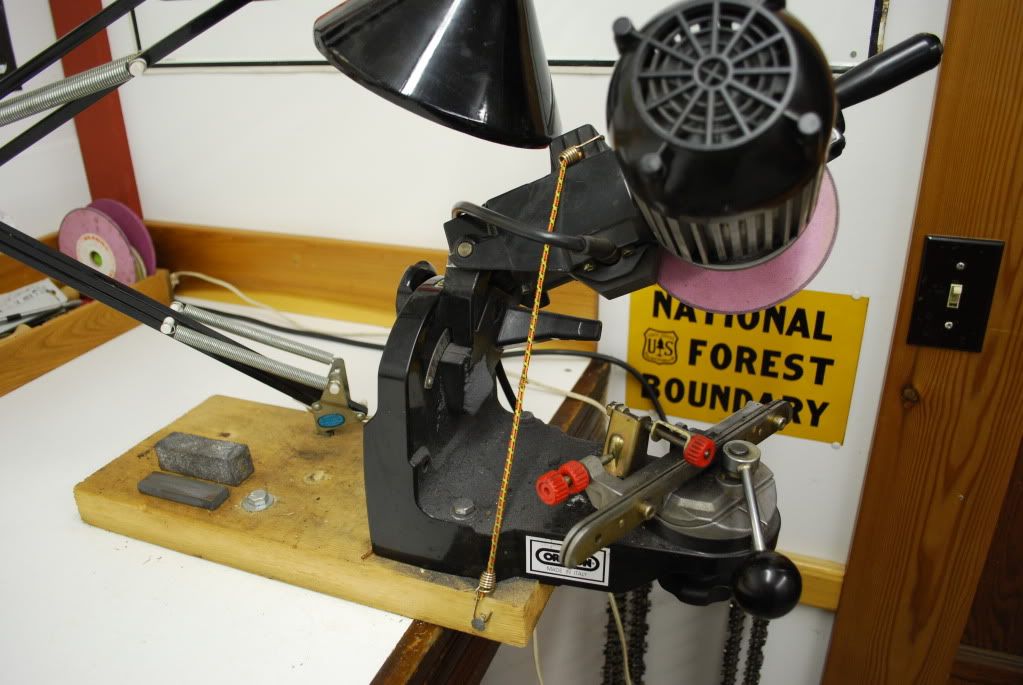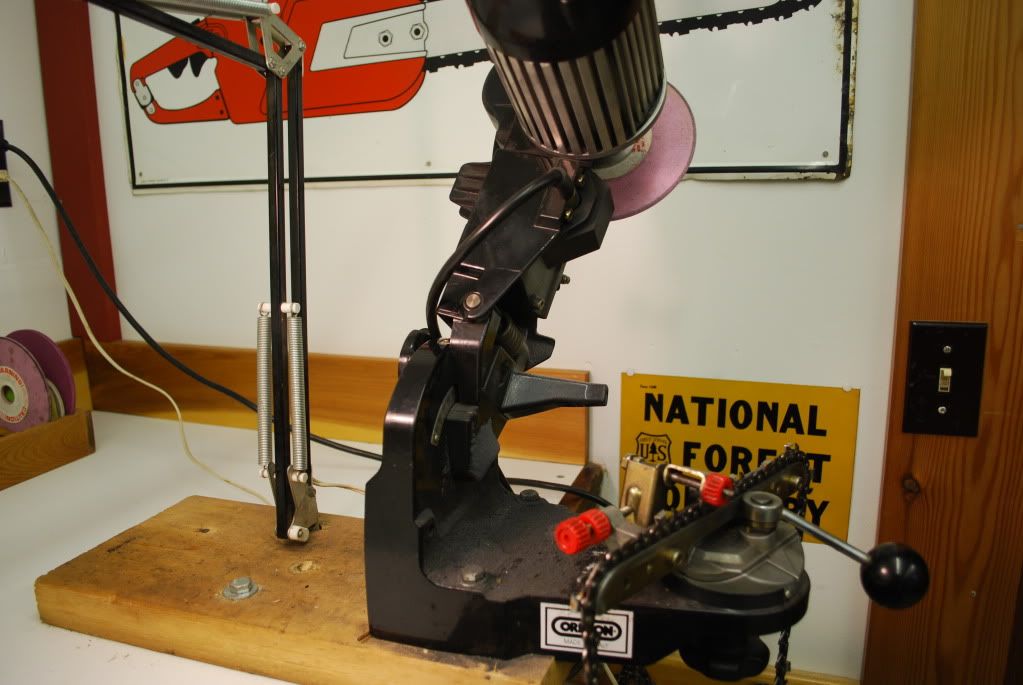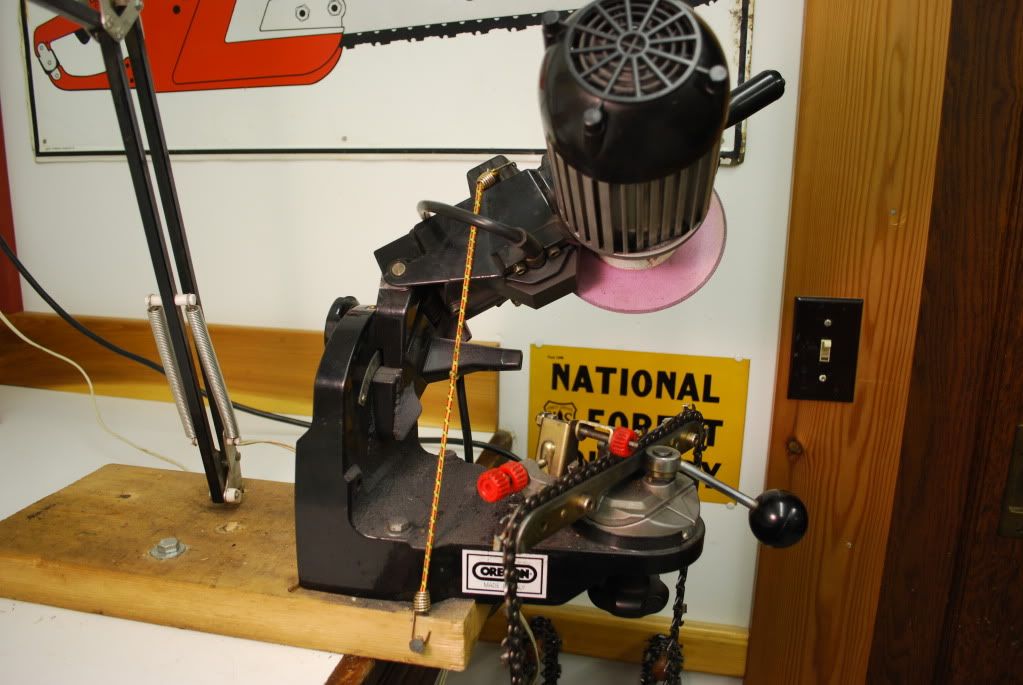I read some of the threads on tweaking the Northern Tool grinders, and thought that we ought to have one for the venerable Oregon 511A (and related Italian grinders). This model does not have the same quality issues as the knock-offs, and I know that it has been replaced by the 511AX, but there still have to be a few million (?) of these things in use.
Please add things you have done, or issues that need to be resolved.
Castings
When I received mine new, the vise casting did not rotate as smoothly as it should. I polished the rough spots on it and the base with fine emory paper and a ScotchBrite wheel. I don't use any grease because the the grit and dust would stick to it.
Angle Scales
There are 2 head-tilt angle scales on the grinder. They did not agree. I removed the scale on the top and elongated the holes with a Dremel tool so that I could shift it over a bit, and remounted it with the screws and double-stick tape. The scales still do not agree over the entire range of movement, but they do at 60 degrees, where I use it the most.
I checked the vise rotation scale, after centering the vise per the instructions, with a factory ground, new out of the box chain, and it seemed to line up at +/- 30 degrees - again the settings I am most likely to use, so I assume that it would be consistent with other settings as well.
Mounting
My grinder is not permanently mounted - it is bolted to a board so that I can clamp it to a table when needed, then put away. I like to grind outdoors when I can to keep the grit and sparks out of my basement.
Grit
I clean the grit off after each grinding session with a brush or compressed air. But some grit 'sticks' the the front of the upper casting. I covered this area with aluminum tape, which can be removed and replaced if this build up gets to be a problem. For some reason, the grit does not stick as tenaciously to the aluminum tape.
Head Travel
Someone noted that the grinding head on their NT grinder travels a large distance to reach the cutters, so he 'de-tuned' his spring to keep it from rising up so much. I did not want to do that. So I threaded a piece of heavy boot lace through the existing holes (for the accessory foot pedal) to limit head travel, but the spring is so strong that it pulled the cord right through the spring-loaded cord lock I used.
After trying a few things, I used a larger cord lock, one that allows me to pass the cord though a second time, and this works. It is infinitely adjustable, allows me to fully raise the head for any reason, and did not require any permanent modifications to the grinder. It definitely saves time when grinding.

Philbert
Please add things you have done, or issues that need to be resolved.
Castings
When I received mine new, the vise casting did not rotate as smoothly as it should. I polished the rough spots on it and the base with fine emory paper and a ScotchBrite wheel. I don't use any grease because the the grit and dust would stick to it.
Angle Scales
There are 2 head-tilt angle scales on the grinder. They did not agree. I removed the scale on the top and elongated the holes with a Dremel tool so that I could shift it over a bit, and remounted it with the screws and double-stick tape. The scales still do not agree over the entire range of movement, but they do at 60 degrees, where I use it the most.
I checked the vise rotation scale, after centering the vise per the instructions, with a factory ground, new out of the box chain, and it seemed to line up at +/- 30 degrees - again the settings I am most likely to use, so I assume that it would be consistent with other settings as well.
Mounting
My grinder is not permanently mounted - it is bolted to a board so that I can clamp it to a table when needed, then put away. I like to grind outdoors when I can to keep the grit and sparks out of my basement.
Grit
I clean the grit off after each grinding session with a brush or compressed air. But some grit 'sticks' the the front of the upper casting. I covered this area with aluminum tape, which can be removed and replaced if this build up gets to be a problem. For some reason, the grit does not stick as tenaciously to the aluminum tape.
Head Travel
Someone noted that the grinding head on their NT grinder travels a large distance to reach the cutters, so he 'de-tuned' his spring to keep it from rising up so much. I did not want to do that. So I threaded a piece of heavy boot lace through the existing holes (for the accessory foot pedal) to limit head travel, but the spring is so strong that it pulled the cord right through the spring-loaded cord lock I used.
After trying a few things, I used a larger cord lock, one that allows me to pass the cord though a second time, and this works. It is infinitely adjustable, allows me to fully raise the head for any reason, and did not require any permanent modifications to the grinder. It definitely saves time when grinding.

Philbert
Last edited:








